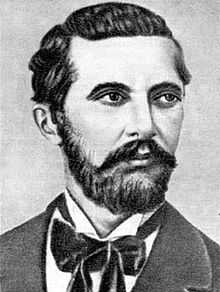Naim Frashëri
| Naim Frashëri | |
|---|---|
 | |
| Born |
May 25, 1846 Frashër, Ottoman Empire, now Albania |
| Died |
October 20, 1900 (aged 54) Kadıköy, Istanbul in Ottoman Empire, now Turkey |
| Occupation | Poet, and translator |
| Genres | Romanticism |
| Literary movement | Albanian National Awakening |
| Children | Mehdi Frashëri |
| Relative(s) |
Abdyl Frashëri (Brother) Sami Frashëri (Brother) Mit'hat Frashëri (Nephew) Ali Sami Yen (Nephew) |
Naim Frashëri (25 May 1846 – 20 October 1900) was an Albanian poet and writer. He was one of the most prominent figures of the Albanian National Awakening (Albanian: Rilindja Kombëtare) of the 19th century, together with his two brothers Sami and Abdyl. He is widely regarded as the national poet of Albania.[1]
Early life and career
It is claimed that the Frashëri brothers (Naim, Abdyl and Sami) were Aromanians;[2] the family hails from Frashër, an Aromanian village,[3] from where their surname is derived from.[2] His father was an impoverished bey from Frashër, in modern District of Përmet. Naim studied at the Zosimea Greek high school of Ioannina, when the city was part of the Ottoman Empire.
As he hailed from a family with long connections to the Bektashi Sufi order, Naim became an Ottoman official in Sarandë, Berat, and Ioannina. In 1882, Frashëri went to Istanbul and started his service in Ottoman culture ministry.
Naim took part in the National Renaissance of Albania, and often had to sign his writings using his initials, as otherwise he would have placed himself in danger working in an official Ottoman position. His works had to be smuggled into Albania[citation needed].
His earliest writings were poetry. The very first pieces Frashëri wrote were in Persian. In all, he authored twenty-two major works: four in Turkish, one in Persian, two in Greek and fifteen in Albanian. His early patriotic poems and highly popular lyric poetry were strongly influenced by Persian literature, and later also French poetry. He also translated several fables of Jean de la Fontaine, Homer's Iliad, and wrote articles on didactics and Islamic practice. Naim's poem Herds and Tillage depicts the activities of the shepherd and the tiller, alongside his personal reflections on the beauty of Albanian landscapes and expressions of longing for his homeland. The epic poem Skanderbeg's Story retells the life of the Albanian national hero George Kastrioti Skanderbeg intertwined with imaginary episodes.
Frashëri died in Kızıltoprak, Kadıköy, a neighborhood of Istanbul, in present-day Turkey.
Family
The renowned Albanian poet was also Ali Sami Yen's uncle, founder of the Turkish football club Galatasaray.
Influence and Recognition

.jpg)
Through his writings, Frashëri exerted a strong influence on later Albanian literature and society.[4] The independent Albanian state created an order of merit that bears his name, awarded to, amongst others, Mother Teresa. A publishing house in Tirana was named Naim Frashëri. Also in his honor some Albanian elementary schools are named Naim Frashëri too.[5]
Naim Frashëri is depicted on the obverses of the Albanian 500 lekë banknote of 1992-1996, and the 200 lekë banknote issued since 1996.[6]
Bagëti e Bujqësi
His most famous work was Bagëti e Bujqësi. The following in an excerpt:
| Albanian lyrics | Translation |
|---|---|
| Bagëti e Bujqësi (Small impression) | |
|
Ti Shqipëri, më jep nder, më jep emrin shqipëtar, |
You, Albania, give me honor, give me the name Albanian, |
Works
- Kavaidiarisiyye ber tarzi nevin (English: Grammar of the Persian language according to the new method), Istanbul, 1871.
- Ihtiraat ve kessfiyyat (English: Inventions and Discoveries), Istanbul, 1881.
- Fusuli erbea (English: Four Seasons), Istanbul, 1884.
- Tahayyülat (English: Dreams), Istanbul, 1884.
- Bagëti e Bujqësi (English: Herds and Crops), Bucharest, 1886.
- E këndimit çunavet (English: Reader for Boys), Bucharest, 1886.
- Istori e përgjithshme për mësonjëtoret të para (English: General history for the first grades), Bucharest, 1886.
- Vjersha për mësonjëtoret të para (English: Poetry for the first grades), Bucharest, 1886.
- Dituritë për mësonjëtoret të para (General knowledge for the first grades), Bucharest, 1886.
- O alithis pothos ton Skypetaron (English: The True Desire of Albanians, Greek: Ο αληθής πόθος των Σκιπετάρων), Bucharest, 1886.
- Luletë e Verësë (English: Flowers of the Summer), Bucharest, 1890.
- Mësime (English: Lessons), Bucharest, 1894.
- Parajsa dhe fjala fluturake,(English: Paradise and the Flying Word) Bucharest, 1894.
- Gjithësia (English: Omneity), Bucharest, 1895.
- Fletore e bektashinjët, (English: The Bektashi Notebook)Bucharest, 1895.
- O eros (English: Love, Greek: Ο Έρως), Istanbul, 1895.
- Iliadh' e Omirit, Bucharest, English: Homer's Illyad, 1896.
- Histori e Skënderbeut (English: History of Skanderbeg), Bucharest, 1898.
- Qerbelaja, Bucharest, (English: Qerbela), 1898.
- Istori e Shqipërisë (English: History of Albania), Sofia, 1899.
- Shqipëria (English: Albania), Sofia, 1902.
References
- ↑ Cornis-Pope, Marcel (2004). History of the literary cultures of East-Central Europe: junctures and disjunctures in the 19th and 20th centuries. History of the Literary Cultures of East-central Europe 2. John Benjamins Publishing Company. p. 291. ISBN 90-272-3453-1.
- ↑ 2.0 2.1 Tanner (2004). p. 213 http://books.google.com/books?id=EQtCPAo1XU8C&pg=PA213. "it is claimed ... Frasheri Brothers ... in fact Aromanians (the Vlachs are also called "Frashëriote" ..." Missing or empty
|title=(help) - ↑ Nitsiakos. p. 142 http://books.google.com/books?id=H-7toRTGrFkC&pg=PA142. Missing or empty
|title=(help) - ↑ Elsie, Robert (2005) "Writing in the independence period" Albanian literature: a short history London: I.B. Tauris in association with the Centre for Albanian Studies p. 100 ISBN 1-84511-031-5 retrieved January 18, 2011 "major source of inspiration and guiding lights for most Albanian poets and intellectuals"
- ↑ http://naimfrasheri.org/
- ↑ Bank of Albania. Currency: Banknotes in circulation. – Retrieved on 23 March 2009.
External links
|